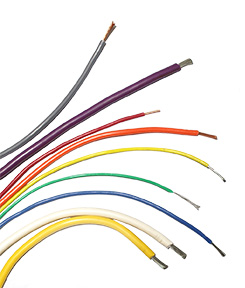Educational Articles
BD Loops Debunks Industry Myth – Loop Wire Gauge

Can loop performance be affected by the wire gauge/size (AWG)?
There is a pervasive myth in our industry that wire gauge does not affect loop performance (aside from tensile strength). This theory’s origin in likely the result of an informal test that was ran years ago that compared two 6’x6’ loops wrapped with different gauge wires. The loops in the test had little to no lead-in (the test does not specify), the results showed that there were slight differences in performance but it was negligible. In our opinion the test had some obvious issues, such as using a small loop size, not including a lead-in run in the test, and not documenting how the readings were obtained, which call the results of the test into question.
What is most bizarre about this myth is its power to cause people to over look basic obvious electronic principles. It is understandable why anyone would want to believe that wire gauge doesn’t matter – you can save money by wrapping your loops out of higher gauge (thinner) wire!
Unfortunately, size does matter. The most basic explanation on why wire gauge matters is because the thinner a wire is (higher gauge) the more resistance there will be to the flow of current. More resistance means more energy loss, which means weaker/less reliable detections. In fact many Department of Transportation (DOT) manuals instruct to never use wire gauges higher (thinner) than 16 AWG when wrapping loops.
But now that we have loosely covered why wire gauge matters, let’s get into a more in-depth explanation how wire gauge affects loop systems. To accomplish this we will compare popular wire gauge sizes for loops in this industry.
AWG stands for American Wire Gauge – the thicker a conductor is the lower its gauge number will be. The amount of copper in wire roughly doubles when comparing wires 3 gauges apart. So for example 17 AWG wire has about double the amount of copper per foot as 20 AWG. This means when comparing the gauges in the chart above 16 AWG has more than double the amount of copper as 20 AWG wire.
In the above chart we compare the resistance and breaking force of 16, 18, and 20 AWG wire. Not only is 16 AWG roughly 3 times stronger than 20AWG wire, it also has 86.6% less resistance than 20 AWG wire per foot. The much higher resistance of 20 AWG wire will decrease the performance of a loop and will result in a loop circuit being less sensitive, or loss of detection height/sensitivity that results in issues such as motorcycles not being detected.
The simple fact is that wire gauge affects the performance of inductance loops, this fact has been well documented in the traffic industry. For gates the difference in performance can be easily seen when comparing large loops or loops with long lead-in lengths. This is because the issues with the increased resistance of thinner gauge wire become more apparent as the amount of wire in a loop increases.
We decided to run a test on how wire gauge affects loops, in our testing we compared a loop wrapped with 16 AWG wire and a loop wrapped with 24AWG wire. We found that the #24 AWG wire had 66% decrease in detection strength (performance) vs. the #16 AWG loop. For small loops such as a 6×6’ with little or no lead-in the difference in performance might be negligible, but for larger loops or loops with longer lead-in it is significant. This test can be viewed here.
A major problem we see with the myth that wire gauge doesn’t matter is that installers often buy spools of #18-#20 AWG wire unaware that the wire should not be used for large loops or for loops with long lead-ins. Higher gauge (thinner) wire spools do not come with warnings explaining that they should only be used for small loops with short lead-in lengths. Installers are often under the false impression that they should not wrap loops larger than a 6×20 because thinner gauge wire is so common in our industry. Nobody ever explains to the installers that they can wrap larger loops, or have longer lead-in if they use lower gauge (thicker) wire.
Knowing this, you might ask yourself why some loop manufacturers use higher gauge wire (thinner wire) in their loop design. Unfortunately that all comes down to dollars, generally half the cost of loop wire is based on the amount of copper per foot. When you purchase a spool of wire to make loops a 20 AWG spool looks about the same as a 16 AWG spool when the wire is insulated. They both sell for about the same price (to installers). Selling higher gauge spools of wire is simply more profitable.
The best advice we can give installers is not to skimp on the loop design with thinner (higher gauge) wire. We suggest a minimum of 16 AWG be used for best loop performance.
BD Loops
The Loop Experts!
BD Loops was founded in 2001. Their preformed loops and accessories are designed with the installer in mind. BD Loops offers a complete loop system solution including preformed direct burial loops, preformed saw-cut loops, loop sealant, blades, testing devices, and installation tools. BD Loops has a reputation for reliability and ease of installation. They pride themselves on the quality of their products and their commitment to providing excellent customer service and support. BD Loops preformed loops are made in the USA at their facility in Placentia, CA.

